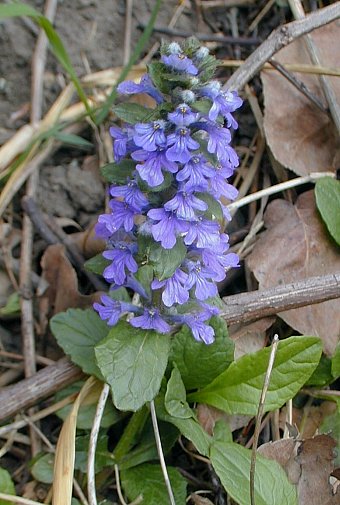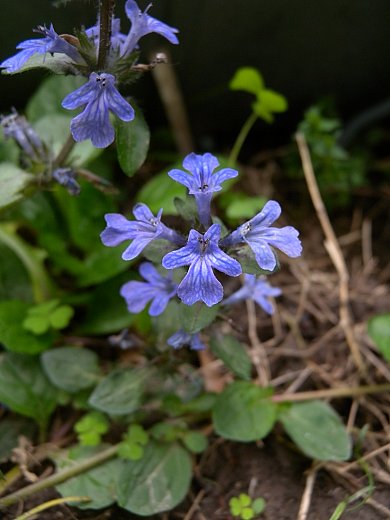Description: This herbaceous perennial plant is 4-12" tall and unbranched, consisting of a rosette of leaves and a flowering stalk. The basal leaves are up to 3" long and 1" across. They are evergreen or semi-evergreen, obovate (spoon-shaped), and nearly hairless. Their margins are crenate and slightly undulate. The flowering stalk is 4-angled and slightly pubescent or hairy. The opposite leaves along this stalk are similar to the basal leaves, except that they are smaller in size and ovate. The flowers occur in a whorled spike along the upper half of the leafy stalk. They are produced in abundance and densely distributed along this spike. Each tubular flower is about 1/2–2/3" (12-17 mm.) in length, consisting of a 2-lipped corolla and a green calyx with 5 teeth. The corolla is usually various shades of blue-violet, and less often pink or white. There are dark blue-violet lines that lead toward the throat of the corolla; they function as nectar guides. The upper lip of the corolla is truncated and very small, while the large lower lip has 3 rounded lobes. The middle lobe of the lower lip is notched at its tip and the largest in size. The outer surface of the corolla behind the lobes is conspicuously hairy; this causes the flower buds to appear hairy.

The blooming
period occurs during the spring and lasts about 2-3 weeks. Each flower
is replaced by 4 nutlets that are oval-shaped and pitted across the
surface. The root system consists of a crown of fibrous roots. Green
stolons up to 12" long are produced from the rosette of basal leaves.
They are largely naked, except for a few small leaves that are narrowly
ovate. These stolons often form new plantlets by rooting at their tips.
Carpet Bugle can reproduce by seeds or vegetatively by means of these
stolons; it often forms colonies.
Cultivation:
The preference is partial sun, slightly moist to mesic conditions, and
a fertile loamy soil that is somewhat acidic. If the soil is poorly
drained and soggy, crown rot can develop and spread rapidly. In sandy
soil, the roots are occasionally attacked by nematodes.

Range &
Habitat:
The non-native Carpet Bugle can escape from cultivation in gardens, but
it is still
uncommon in the wild, occurring in NE Illinois and Jackson County in
southern Illinois (see Distribution
Map). Habitats include partially
shaded areas of lawns, edges of yards, partially shaded areas
along foundations of buildings, nursery plots, and edges of woodlands.
This plant is occasionally used as a ground cover because of its
evergreen leaves and low spreading habit, but it is potentially
invasive of natural areas. In Eurasia, where it is native, this plant
occurs in partially shaded areas of deciduous woodlands, thickets, or
meadows; the flowers bloom before the leaves of the trees have become
fully developed.
Faunal Associations:
The flowers are pollinated by bumblebees and other long-tongued bees.
According to sources within the horticulture industry, the foliage is
rarely bothered by rabbits and deer.

Photographic
Location:
The photographs were taken underneath a tree at Dave Monk's postage
stamp prairie in Champaign, Illinois, and along the side of a house in
NW Ohio.
Comments:
Different cultivars of Carpet Bugle are available through the
horticultural industry that can vary considerably in the color of their
flowers and foliage. The only other Ajuga sp. that
has naturalized in Illinois is Ajuga genevensis
(Geneva Bugle). This species is slightly taller with stems and leaves
that are more hairy than Carpet Bugle; it also doesn't produce stolons.
Carpet Bugle is easy to distinguish from other members of the Mint
family because of the following combination of features: 1) Its
blue-violet flowers are ½" in length or slightly larger, 2) the upper
lip of the corolla is truncated and quite short, 3) the flowers occur
in a terminal whorled spike, 4) the flowers bloom during the spring on
stalks that are 1' tall or less, and 5) above ground stolons are
produced in abundance from the rosette of basal leaves. This latter
characteristic is especially useful in identifying this species because
very few members of the Mint family produce above-ground stolons.